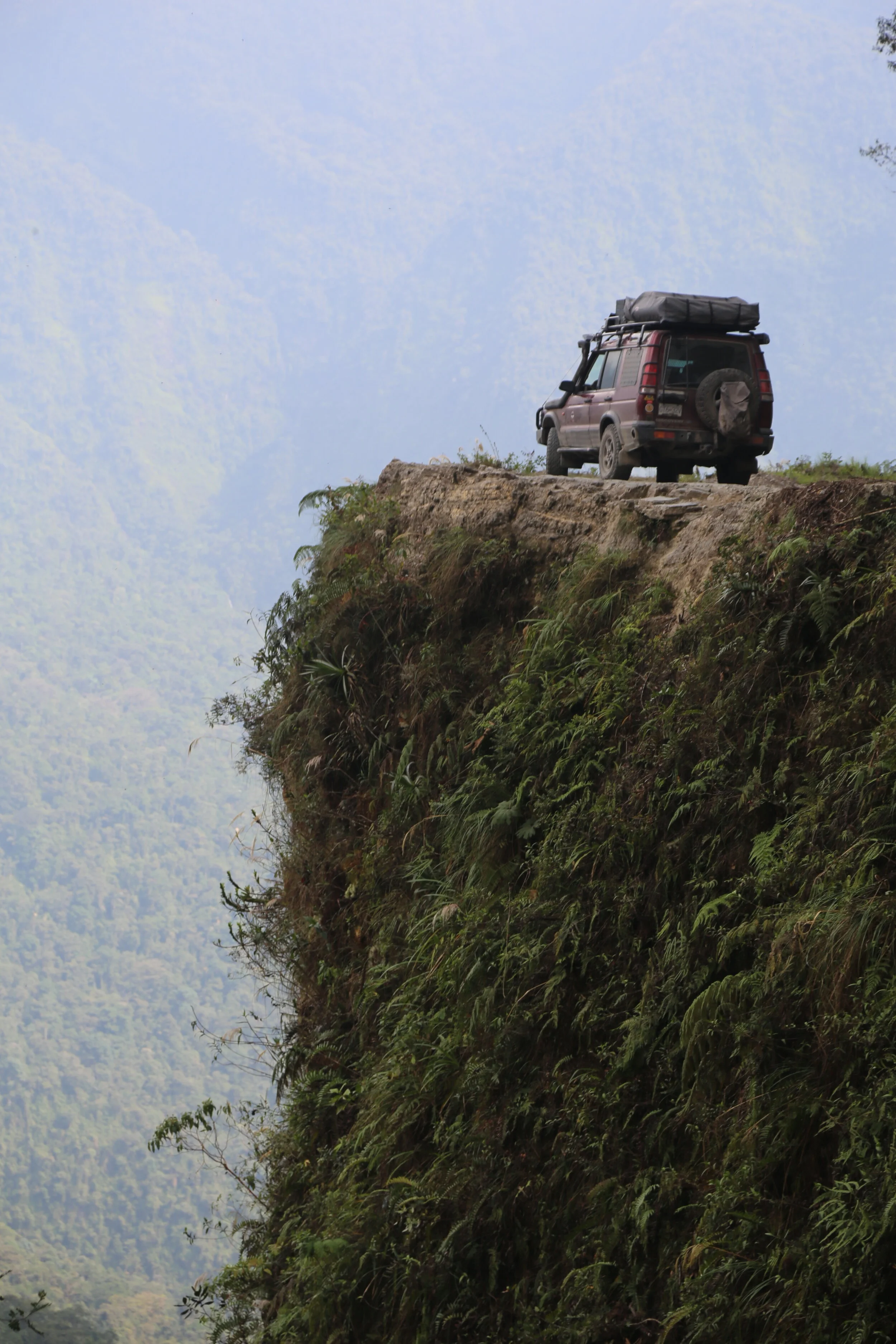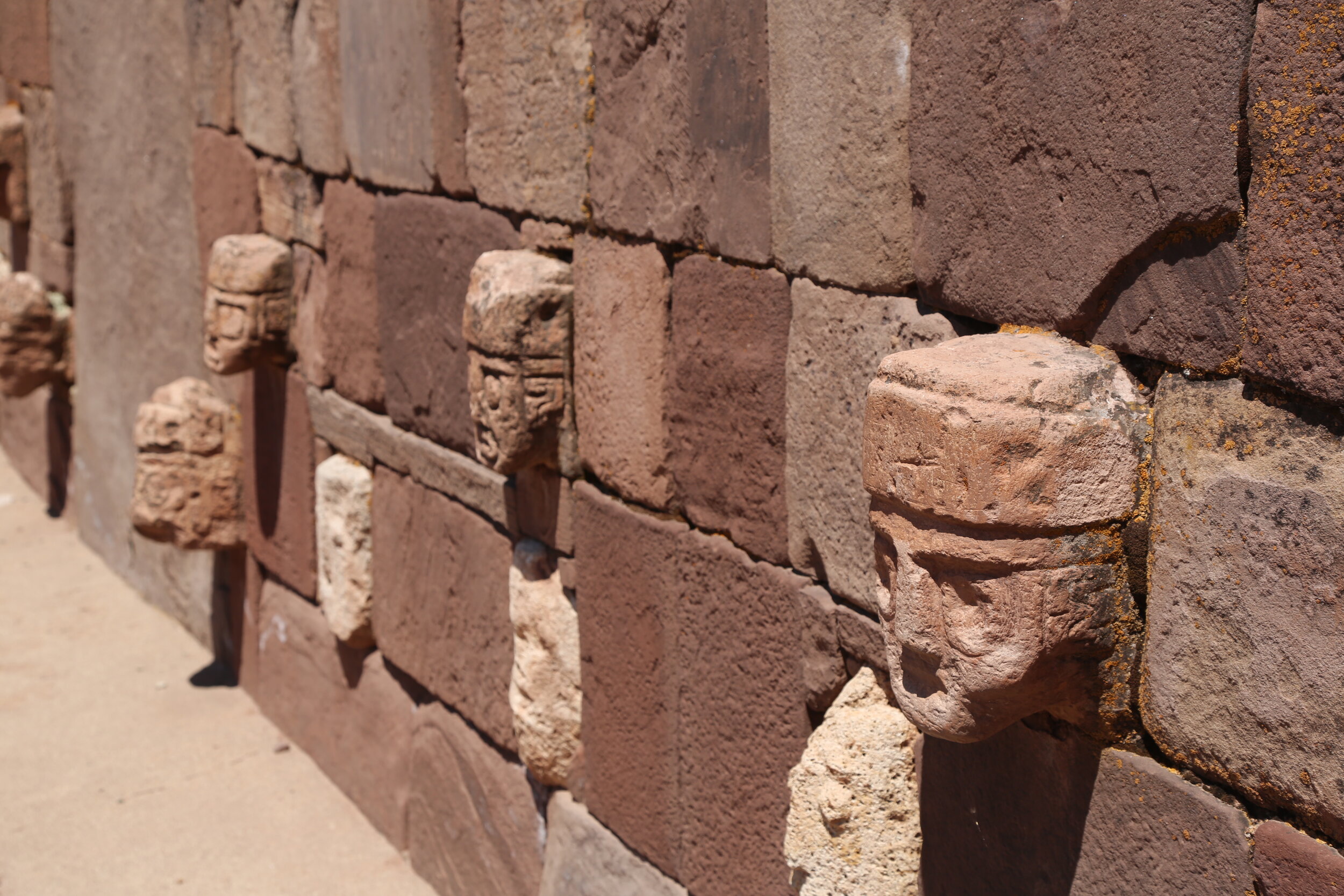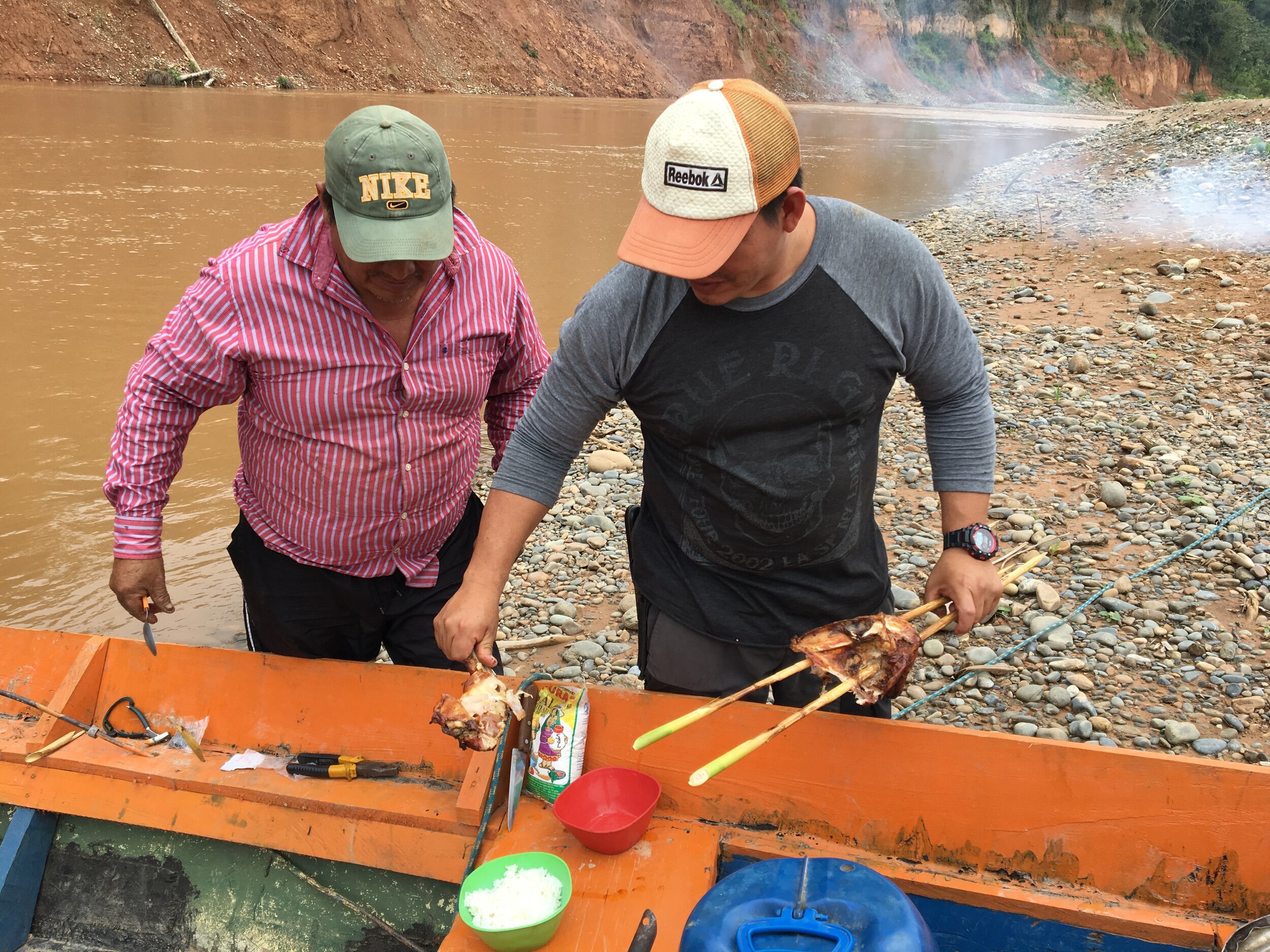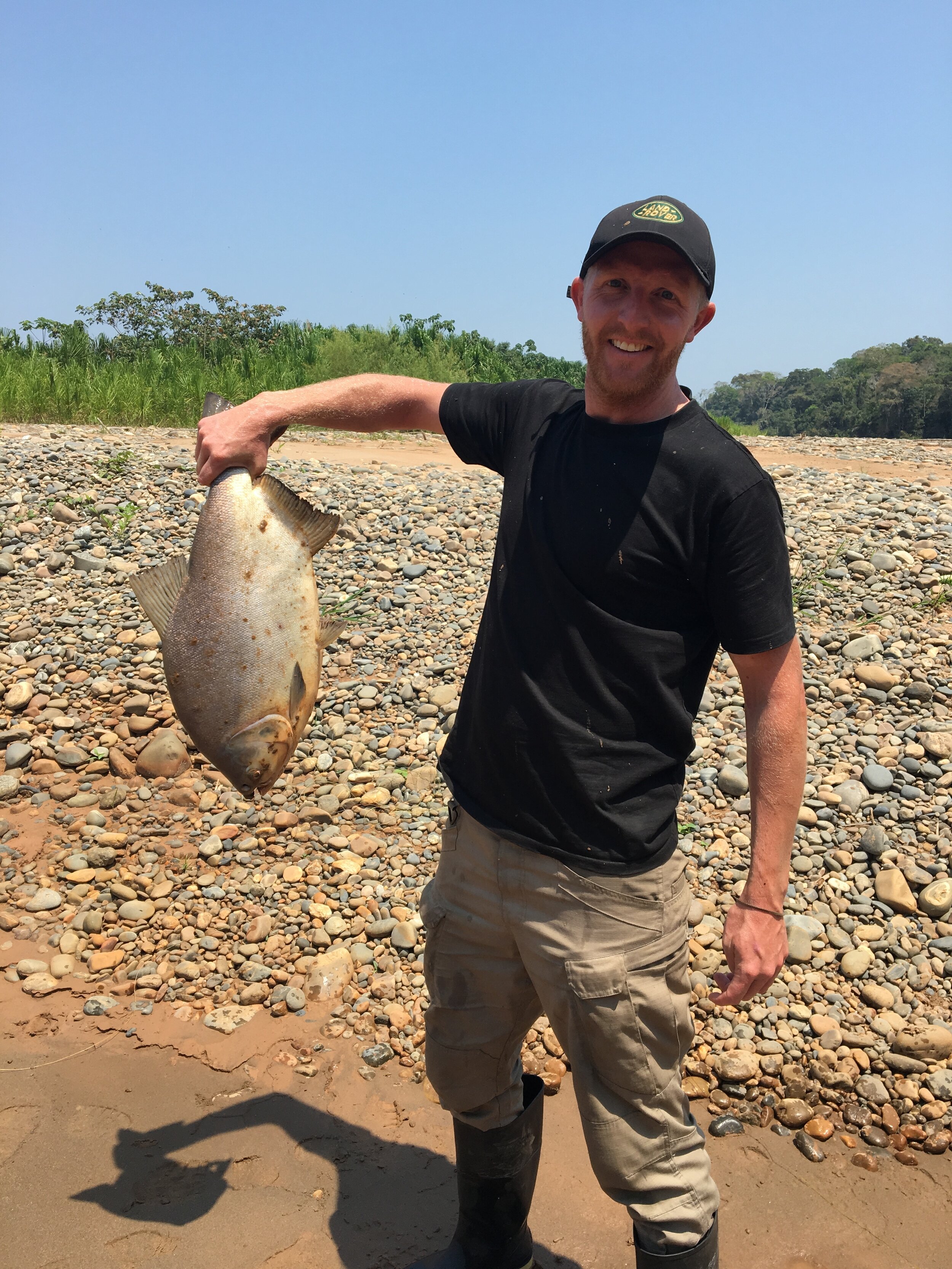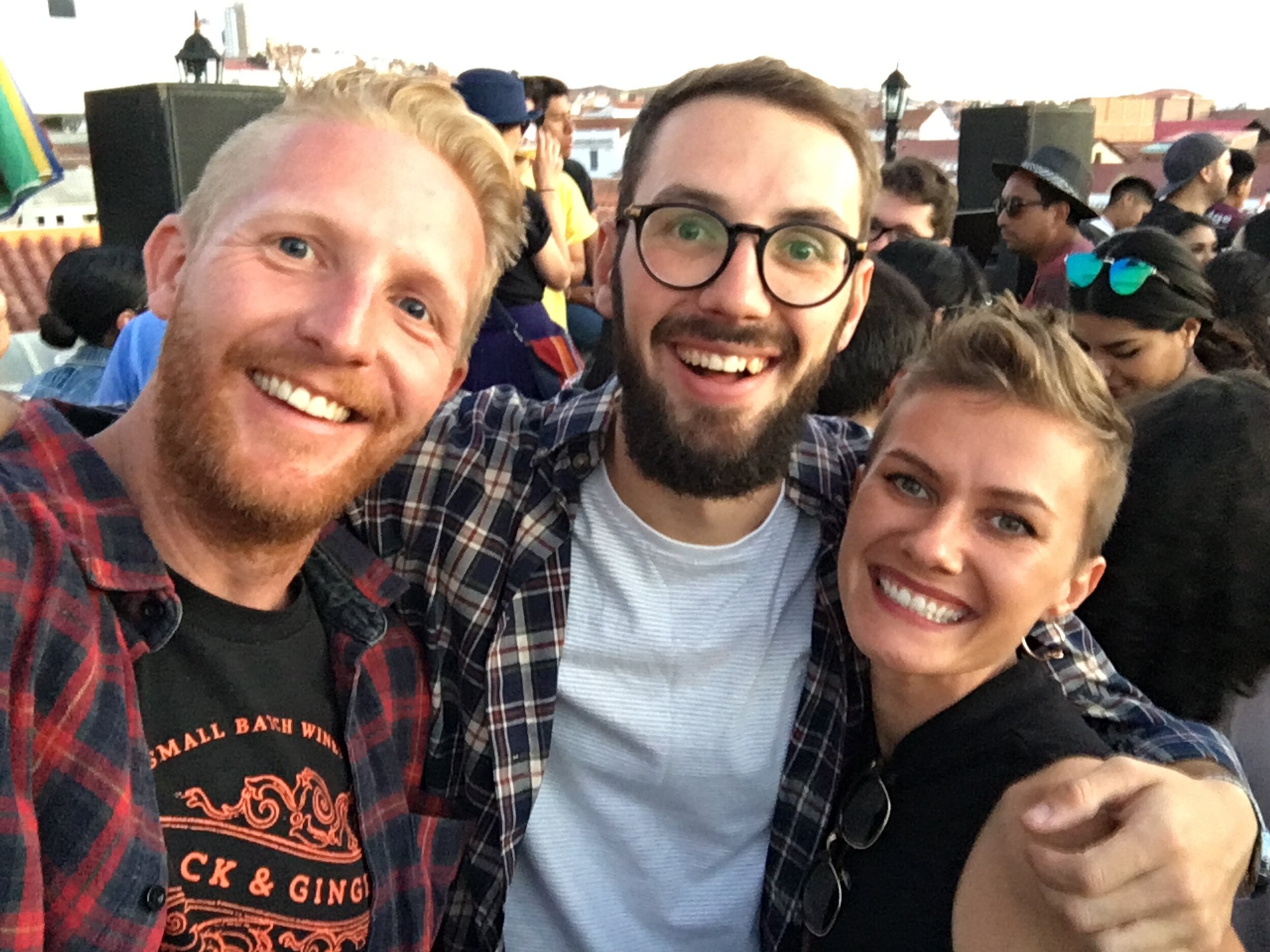Bolivia
Crossing at Desaguadero
Feeling like a bit of a tourist after leaving Peru, I was keen to have an adventure in Bolivia. This is exactly what I got and it would prove an interesting and challenging country for me. My time in Bolivia would be mostly jungle, mountainous roads, rolling countryside and eventually the salt flats - just what I was looking for… plus a lot of problems along the way.
Arriving into Bolivia wasn’t as smooth as I was hoping for. On the final stretch to the border in Peru, I had to duck into a backstreet after being paranoid that a police car was following me and trying to give me a fine (demand a bribe) for speeding. And when I arrived in the border town of Desaguadero, it was far from the most friendly feeling place I had visited – stray dogs seemed to own the streets as they feasted on scraps from the rubbish and the dimly lit streets of the town appeared ominous as I sought a meal before settling in for the night in preparation to cross the border to Bolivia the next day.
Waking up in a cheap hotel that smelled of turpentine, I would make my way to the border in the centre of town only to realise that they had moved the border a few kilometres to the south in the past year and that my research on crossing logistics was obsolete. The result was that I ended up in a downtown market in my car trying to force a path to the border bridge that was no longer, all the while being tormented by another misfire code on the Land Rover and then get helped by a security guard that kindly offered to jump in the passenger seat and guide me to the new border building outside of town and asking only for taxi money back to his job in return.
Problems persisted at the border when I learned that because I entered Peru on my US passport, I also had to enter Bolivia on that passport and this necessitated a couple hours scrambling to do a visa application at the border, fabricating various documents I didn’t have (and to be fair no overlander would have) with the help of the border guard and having to pay US$160 for the privilege of a visa (in spite of the fact that Australians can enter freely and simply). Bad luck would follow me most of my passage through Bolivia.
The ominous and dimly lit streets of the Desaguadero border town
Taking a quick break and ducking away from a policeman in search of a bribe
Nothing like minor engine problems to compound an already stressful morning. This one was not to present an immediate issue but foreshadowed a bigger problem later on in Bolivia
Central Desaguadero: trying to forge a path to the old border based on outdated information - shortly after this moment I learned from a local they had relocated the frontier to a new building just a few minutes drive south of the city
Tiwanaku
I had been told about an archaeological site worth a visit before arriving in La Paz and so made a small detour into the town of Tiwanaku. The modest town is located adjacent to the Tiwanaku ruins which are the remains of a civilisation that peaked in about AD 800 and likely consisted of some 10,000 to 20,000 people. I would later learn that the site, located near to the shores of Lake Titicaca, is one of the most important archaeological sites in South America, a UNESCO World Heritage Site and the remnants of an important and once-powerful civilisation of the area.
Despite its historical importance, the site doesn’t have much infrastructure to provide explanation. One simply parks in an adjacent lot and wanders in, free to peruse the site without much in the way of context. Workers are present on the site, supposedly excavating additional ruins but don’t appear to be in a particular rush to do so. It was a stark contrast to Machu Picchu and the gears of the tourist machine that had built around it.
A nice relaxed wander through the site without many others there at all
I don’t blame them for relaxing in the shade - it was hot
La Paz
I had little desire to spend more time than necessary in big cities at this point – the Bolivian Amazon and the Salt Flats of Uyuni were my primary goals for my time in Bolivia. Nevertheless, the capital of La Paz was the logical first stopping point to orient myself in Bolivia before heading into the jungle. The key driver, other than to see how the city had changed in the ten years since my last visit, was to stop in at a mechanic and have a regular service done on the car before heading into the remote Beni Municipality.
The sight of the city is spectacular as it sprawls through the valley and the structures and homes cover the arid soil of the highest capital in the world (around 3,650m). The traffic and chaos of the streets is probably second only to Lima and the layout of both the roads and city make it a disorienting place to drive. Meanwhile the teleferico above offers a relaxed way to traverse the city and take it all in.
Arriving at my hostel in the centre of the downtown area, my first night in La Paz would be memorable for being robbed – my first time a victim of crime in this trip. After a few drinks (maybe one too many) in the hostel and headed out to get some food, a pick pocket reached into the pocket of my shorts, took my phone and ran. I was immediately aware of what had just taken place and chased him through the streets. Unfortunately, a combination of the thief’s youth and the high altitude of La Paz gave him the upper hand and he outran me. So my few days in the big Bolivian city would be focused on recovering from this event – dealing with a police report and porting my digital life over to my backup phone.
La Paz, Bolivia
La Paz as viewed from the Teleferico - a unique network of cable cars connecting the city
Marcelo’s workshop in La Paz which would be home for one night and where I spent much of my time while in La Paz just hanging out with the mechanics
La Paz traffic zebras: a government initiative begun in 2001 as a tool to educate the populous on the use of crosswalks (zebra crossings). Also made popular by their feature on Last Week Tonight by John Oliver
Filing a police report in downtown La Paz for my insurance on a pick-pocketed cell phone. Not a smooth or easy process but made better by the kind security guard at my hostel who offered to accompany me
Land Rover club of La Paz
Through my mechanic and new friend Marcelo, I accepted an invitation to join the local Land Rover club for dinner. Six Land Rovers assembled in front of a food truck parking lot where we admired each others vehicles and compared modifications. I shared stories of my adventures with them over some food and then, in convoy, the trucks made their way to a lookout above the city. As we arrived, romantically entangled teenagers in their cars scattered as we lined up the cars in front of the bright lights of the city for some photos and to enjoy the view.
No matter how many times I find myself in a foreign city with the local Land Rover groups, I’m always blown away by how generous, hospitable and passionate they are. No matter where I go, there is always a new set of friends ready and waiting for me to join them in their regular meets and invite me into their lives for a short while.
These guys made me and my Discovery 2 feel at home after meeting them through the local Land Rover workshop
Dinner with the La Paz Land Rover club
Five Discoverys overlooking La Paz
La Paz by night
Drone shot of the Land Rover club with our cars lined up behind us
Honorary member
Death Road
Most young backpackers that pass through La Paz will find themselves visiting the Death Road, or North Yungas Road, as one of their activities. I was no different the last time I travelled to Bolivia almost exactly ten years earlier. But driving the Death Road in my own car was something that I had been looking forward to for many months. Some overlanding friends that I’d met had assured me it was possible and as luck would have it, it was a logical starting point on my journey north from La Paz into the Bolivian Amazon.
Getting there is simple enough. One drives out of La Paz towards the high point of the city, passes through La Cumbre – the high pass above – and then follows the valley down the mountain. It’s the same route that is frequented daily by tour buses transporting busloads of young backpackers and mountain bikes as they take their chances riding down the infamous road. For my part, an early start had me off at dawn and passing through La Cumbre hours before the bikers had set out for the day giving me an opportunity to drive the road without a single other soul on its dangerous curves.
After a couple hours to crest at La Cumbre and another couple of hours down the Death Road itself, I completed one of my favourite days of driving in almost a year on the road. It was an experience that won’t be easily forgotten.
La Cumbre
The view towards the Death Road from La Cumbre
Right from the beginning of the day, crosses lined the street from La Cumbre right through to the end of the Death Road
Welcome Death Road Keep Your Left: The left side (opposite to the normal driving side) would be an uncomfortable place to overtake on the death road as your left wheels would tread perilously close to the edge. Thankfully I didn’t encounter another vehicle the whole way down
Gas in Bolivia
One of the biggest challenges of overlanding through Bolivia is filling up your tank with gas. There’s an interesting situation that exists which is relatively unique to Bolivia which is that fuel subsidies are provided only to locals and not to foreigners. While many countries subsidise gas, rarely - if ever - do they discriminate between locals and foreigners and even though you can understand the reason for doing so, it’s a headache for both locals and foreigners alike as each person’s license plate is recorded on a government system at every fill up. So while gas stations are common enough, filling up as a foreigner is not straightforward.
The local rate when I visited was 3.70 Bolivianos per litre or about US$0.55. However, in order to access this price you need to have local license plates. Foreign plates attract a higher rate at between 8.0 to 8.8 Bolivianos, or a relatively expensive US$1.20 litre. The pain isn’t just a financial one – often times the local attendants don’t know how or simply refuse to sell gas to foreigners making a journey in remote places particularly difficult when one can’t simply buy fuel even when you pass an otherwise decent service station.
The reality of situation is that each time you feel up, it’s a gamble on how it will play out. Maybe 10 or 20% of the time, they will give you the local price and you quietly rejoice that you both have fuel as well as a cheap price. Others have a standard ‘sin factura’ (without invoice) price which may be 30 or 50% higher than the local price (5.0 Bolivianos was common) and it’s always worth asking for this if they try to ask you for the full foreigner rate. Others you simply offer a cash payment to the guy at the pump to give you the local rate, let him record a local license plate number down as part of his paperwork, and let him pocket the tip. But, unfortunately, many times, they simply turn you away and you’re left scrambling to figure out where your next fill up point is.
And of course much of the time, cash payment is required necessitating frequent trips to the ATM and ensuring you have plentiful supplies of cash on hand especially in more remote areas where you have a coincidence of both infrequent ATMs as well as it being more likely that they don’t take a credit card.
For this reason, driving in Bolivia can be a stressful affair. As I started my journey through the Death Road into the Bolivian Amazon towards Rurrenabaque, the uncertainty surrounding my ability to fill up when and where I needed was the biggest concern and source of anxiety.
The Road to Rurrenabaque
Ten years earlier I had travelled with friends from La Paz to Rurrenabaque – a small town in the north of Bolivia on the Beni River. Many people go to see the Pampas or Madidi National Park, staying in jungle camps and from there you can see monkeys, caimans, turtles, anacondas and pink river dolphins. In that trip in 2010, we had been scheduled to fly on a small prop plane but the grass airstrip had become inundated with water, so after much waiting around at the airport without luck for the conditions to improve, we commissioned a local with a Land Cruiser to take us there.
The journey was long and took us a whole day of driving that went late into the evening. We passed buses and trucks on mountainous cliff-side roads, bounced over muddy and sandy jungle trails and eventually arrived in Rurrenabaque rattled, sore and tired from an epic day driving through remote areas. I recall having to stop at least twice to address issues with the car – a flat tire and an issue with the suspension that our driver expertly fixed himself.
With this past adventure in mind, it seemed like a personal challenge that I should recreate this drive and test my own skills for navigating such an extreme driving day. Add to this that I would do it alone and in my own car which had repeatedly proven to be less than reliable to keep things interesting.
One of the friendlier service stations that offered a ‘sin factura’ price without any negotiation
The start of the day featured quite heavy rain making for interesting driving conditions
Thankfully wasn’t the first to go through here and the path had previously been cleared
Much like the North Yungas (Death) Road but this one is still in use
It’s a 200m drop to the river below
The Death Road covered the first part of the drive to Rurrenabaque. I would stop after that for the night in a small and strange hotel called Villa Verde. It’s an out of place hotel in the middle of Ruta Nacional 3 outside of Coroico. The hotel served as a lunch spot for many of the mountain biking tours. In parallel, it also had a water park out the back and appeared to be a popular destination for local families looking for a place to take their kids on a hot weekend.
The nine-hour drive from Villa Verde would take me along cliff edges, through roads covered with mud slides, at times in pouring rain, passed many tiny ‘pueblos’ and then passed the larger mountain town of Caranavi. The route was mostly trucks transporting goods in the remote Amazon region and at times made for very interesting overtaking on the narrow roads.
Eventually, I found myself in the town of Rurrenbaque having accomplished this personal challenge without incident. Searching around town, I found a little watering hole – Mosquito Bar – that I recalled from my last visit and rewarded myself with a cold beer in the hot and humid jungle climate.
The final stretch before Rurre
Some failed cryptocurrency startup?
The road to Caranavi
A typical pueblo along the Ruta Nacional 3
Rurrenabaque
Still with the mentality of doing things a little different and trying to find the most adventurous path, I set about looking for something to do in Rurre. Most people find an agency and book themselves into some sort of coddled jungle itinerary to the Pampas or Madidi National Park. But I was looking for something different.
Having realised that the area was home to some weird and wonderful fish, I set about looking for a guide. I managed to track down a fisherman and his son who would take me on their boat into the Amazon for a couple days. This was perfect and I couldn’t have been happier with the plan. Not only was I going fishing, I was doing it with a family who would show me the local methods both of fishing but also of how they camped in the jungle.
So the next morning a dawn, I met up with Silverio and his son Choco. We filled jerry cans with fuel for the outboard and gathered supplies before heading down to the dock, getting onto their boat and cruising four hours up river to their favourite fishing spot. At lunchtime, I fished with Sivlerio while Choco prepared us all some chicken on a campfire he made on the shores of the Beni River.
The afternoon’s fishing didn’t yield much and after moving between a few different locations, it was beginning to get dark. Wondering where we’d sleep that night, they eventually pulled the boat up on shore and with machetes, cut down several lengths of bamboo. Within 45 minutes, they’d constructed a makeshift tent complete with a tarpaulin floor and roof and mosquito nets.
Headed up the Beni
Choco cooking up a delicious chicken meal for the three of us
Father and son making a great team
Our accommodation for the evening: comfortably slept the three of us
The sun going down over the Amazon jungle
Breakfast of eggs, fried bread and coffee
After camp was set up and as the sun went down, Choco and I set lines secured to rocks hoping for catfish while Silverio cooked pasta. As we ate dinner, we heard a violent movement of rocks from the shore and I raced down to pull in a big catfish. We’d pull in three more before the night was over.
The next day was another slow start to the fishing and I was beginning to think the day would catch nothing all day. We were down to our last worm and my lures weren’t the right tackle for the muddy waters. But a few minutes after baiting the last worm onto Silverio’s improvised fishing rod, we had a strike. I was quickly over at the line and after five minutes of fight with the fish on the other end, eventually had it to shore. I’d caught myself a ‘paku’ – a relative of the piranha only much bigger. This one weighed in at 4kg.
Happy with the haul from the trip and now out of bait, we set about preparing lunch before the four-hour trip back to Rurre. Silverio served up catfish head soup which, if I’m honest, was a bit of struggle to enjoy but nevertheless nourishing.
As we cruised back home, I was honoured when the guys invited me to join their family to enjoy our fresh catch together. There was certainly plenty of fish to share and after a couple days of becoming close with the guys, it was a nice prospect to be able to share with their family.
Silverio, the patriarch of the family, had eight children and 28 grandchildren and, of those, probably around a quarter of which lived in his house with him. Over dinner and with wine in hand, Choco and I teased Silverio as we challenged him to name each and every grandchild - he could only name 17 of the 28. It was lovely to get to know his family and share the catch with them. As a solo overlander, a home-cooked family meal is a rare treat and made all the better in such a unique circumstance as this – a truly memorable meal and a unique experience.
The grin says it all: happy with my catfish
Paku: cousin to the piranha but much bigger
The teeth of the paku look pretty menacing so we kept our fingers clear
Catfish head soup
Paku for Sunday dinner with Silverio and his family
Silverio serving up dinner
Breaking down in the jungle
Pleased at having accomplished the challenging drive into Rurrenabaque and a genuine Beni fishing adventure, it was time to head out and keep moving through Bolivia. So an early morning start had me at a locally renowned French bakery (with genuine French chef) and back on the road.
I’d made it less than 100km out of Rurre before a grim ‘service engine soon’ light appeared and began to flash. While I’d seen the warning light many times prior – it never flashed and obviously was more serious than other such lights I’d received. Knowing the drill, I pulled out my scanner and saw that I was having misfires on two cylinders and the fact that the warning light was flashing meant that driving it in this state was pushing unburnt fuel through the exhaust which would melt the catalytic converter. This wasn’t something I could ignore so I set about fixing it before starting back towards the big city of La Paz.
I’d done the misfire dance before and had a pretty good inclination it was between spark plugs, spark plug leads, coil packs, injectors or bad fuel. This was confirmed by a mechanic friend in California who I managed to get a message out to. Thankfully I was prepared enough to be carrying all the spares I needed. So, in the 35C heat with the sun pummelling me from above, I set about starting to diagnose and solve the issue. A short while later, having switched out the spark plugs and topped up the tank with known high quality fuel from my jerry cans, I’d eliminated a few culprits and now figured that coils or leads were my issue – and they would require removing the plenum off the engine. For that I was going to need a workshop and easier said than done given where I was.
In a stroke of luck, I was only a couple kilometres from the next town. Having said that, Yucomo wasn’t much of a town and my chances of anything more than the most basic assistance were slight.
Risking the short drive with the misfire unresolved, I carefully limped the car into the town of Yucomo. Sourcing some injector cleaner and running it through the engine without any improvement, I assessed my options. Getting a tow truck back to La Paz, it turns out, would be hideously expensive so I knew my path and tracked down probably the only mechanic in town. After another short and trepidatious drive, I lay eyes on his workshop - it wasn’t much to look at and didn’t exactly fill me with hope.
Even before arriving, I’d read multiple reports about how good this bakery was and it didn’t disappoint
The town of Yucomo where I would try to track down a mechanic
The sign for my mechanics workshop
Inside the workshop
The family run workshop wasn’t much to look at but the guys were confident and didn’t waste much time shelving their other jobs to get to work on my truck. Together we pulled off various hoses, the air intake, disconnected sensors and after an hour or so had the plenum off. In our haste we managed to snap a vacuum hose connector but otherwise it went smoothly. After a few hours we’d swapped the coils and leads and as the day grew dark, we had everything back together again. A quick run to a local machine shop and the guys came back with a fix for the piece that they broke and while not perfect it held and did the job.
By this time, it was 8pm and 12-hours after the warning light first came on. From what we could tell we’d done a good job and it was back together again properly and we’d replaced what we hoped were the offending parts. But after such a long day in the searing jungle heat, I didn’t have it in me to test the car that evening. I wasn’t mentally prepared for the event that our fix didn’t hold and the problem persisted. I figured I’d sleep better assuming the car was right rather than the chance of knowing for certain that it wasn’t. So with that, I popped the rooftop tent right there in the workshop, put away a few cold beers to ease the nerves and called it a night.
Starting work to replace the coils and leads
Plenum off to get at the coil packs (located near the firewall behind the engine)
Waking up in the morning and preparing to drive out
The next morning, I did a 30-minute test drive back and forth along the empty streets of Yucomo knowing it was far better to discover we hadn’t finished the job before setting back off into the sparsely populated jungle roads towards La Paz. The test went smoothly and I had enough confidence to set out again. And so I was back on the road with several days of driving in front of me out the way I came, back through Coroico, La Paz and then on to Potosi.
The following were long days of driving through dry rural areas. I would pass through canyons and hills, see grubby faced children at toll roads selling candy and hundreds if not thousands of campaign signs for Evo Morales in aid of his upcoming Bolivian election bid. Driving the country at the time, you wouldn’t be aware that another candidate besides Morales was in the running based on the overwhelmingly large number of murals plastered with his name. Things would go badly for Morales only months later after the Bolivian people questioned the legitimacy of his election win over rival Carlos Mesa, the country would be plunged into political chaos and Morales would flee to Mexico and then to Argentina seeking political asylum.
In Potosi my plans would be derailed by a coincidence meeting with a fellow overlander who had enlisted seven other backpackers to accompany him to the Uyuni salt flats. The opportunity to do the flats as a big group in two cars was too good to turn down so my plans were flexed to accommodate this new plan – I would rush on to Sucre while they prepared themselves for the excursion and we’d meet a few days later outside the salt flats.
Crossing Bolivia
Evo Morales for president 2020
Toll points on the country roads are often where people (frequently children) can be found selling food and drinks to motorists
Sucre
In my mind, Sucre turned out to be the gem of Bolivia. It’s quiet, clean and charming. These days would be a much-needed rest after a month or so of daily driving and adventures – something that can be much more exhausting than I ever would have thought when not taking the time to rest.
For several days, I’d roam the calm and charismatic streets of Sucre, enjoying the plazas and miradors and recharging in readiness for the next adventure.
The cobbled streets of Sucre
The warm lights of a Sucre street market
One of Sucre’s many charming plazas
I suppose this must have been a weekend. There were at least four couple battling for prime position to take their post-wedding photos in this plaza
Only a few hours after the wedding: looks like he enjoyed the reception
Sucre had a surprise left for me in the form of a reunion with several friends I’d made in my brief stay in Rurrenabaque. Apart from the colonial architecture, Sucre is apparently known amongst travellers for having some great rooftop parties. So, on my last night in town, we watched the sun set on the city of Sucre from a rooftop party with fernet & cokes in hand and a DJ spinning vinyl.
Met these two in Rurre and coincidentally ran into each other in Sucre. Crazier than it sounds given they are over 20 hours drive / 1,100km from each other
Leaving Sucre behind, I set off to re-join with the Pepe and his team of travellers on the salt flats. Passing an upturned bus and stopping to negotiate the purchase of firewood with a local family on the roadside, I set my navigation to Uyuni ready for three days on the salt flats with three Americans, two French, two Australian and a German in what would become one of the more memorable periods of the trip so far.
Pepe’s car: a right-hand drive Japanese import Toyota which would be the other half of our convoy to the salt flats
I have no idea how they turned this over. But then months later I’d turn my car over and you’d have the same thoughts looking at the photos of mine
On the way to Uyuni, I stopped to introduce myself to these lovely people and negotiate the purchase of some of their firewood
Loaded up with firewood for Uyuni, I hit the road ready to meet up with my new friends

